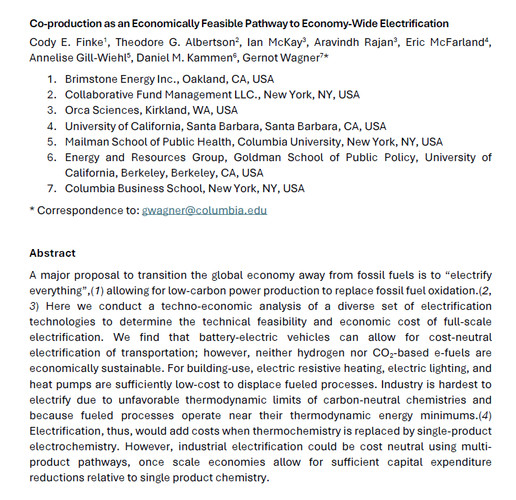To help cool the climate, add aerosols
Solar geoengineering may be a bridge to a cleaner future

By David Keith and Gernot Wagner
SLASHING SULFUR DIOXIDE pollution in the United States and Europe over the past decades counts as one of the biggest environmental success stories. Air pollution kills. The US Clean Air Act will add more than a year of life to the average American. But decreasing this pollution also comes with an important, unintended, and unexpected consequence: a warming planet.
Aerosols, the fine particles in air pollution, reflect a small portion of sunlight back into space and, thus, actually help keep global warming in check. That’s true despite the carbon dioxide emissions coming from the same smokestacks that warm the planet.
Global warming doubters now like to point to fears of global cooling in the 1970s as proof that climate scientists can’t get their story straight. That assertion is entirely wrong. Concerns in the 1970s—and predictions around global cooling—were correctly based on the cooling power of aerosol pollution. The US National Academy of Sciences released a report in 1975 that got this point exactly right, noting that the warming power of long-lived carbon dioxide would eventually overwhelm the short-lived cooling power of aerosol pollution. Predictions around global cooling proved incorrect because the US and Europe managed to slash sulfur dioxide pollution and, at the same time, accelerate the massive increase in carbon dioxide.
Since the 1970s, Europe has managed to cut sulfur dioxide pollution by 75 percent. This has brought huge benefits, but it has also likely increased temperatures in the Arctic by half a degree Celsius since 1980. A conundrum: Society ought to cut air pollution much further, but it doesn’t want the additional warming, faster sea-level rise, and more intense hurricanes that come with it.
What then if the world were to reduce aerosol pollution in the lower atmosphere while deliberately injecting sufficient aerosol into the upper atmosphere to keep global temperatures in check? The former would very clearly save lives.
The latter is called solar geoengineering. Early research suggests it is quite promising, and it might require only one-fiftieth of the amount of aerosols now polluting the lower atmosphere to achieve the same cooling. It, too, could save many lives. Aerosols in the upper atmosphere appear to have much smaller health impacts for the same amount of cooling, while decreased global warming comes with many direct positive climate and health benefits.
Much more research is needed on solar geoengineering—both on its efficacy and on potential risks. The US National Academy of Sciences and environmental groups like the Environmental Defense Fund and the Natural Resources Defense Council support careful research. The Chinese government has a small research program.
To date, there is no US government program, likely because of fears that mere talk of solar geoengineering lets polluters off the hook. Of course, solar geoengineering alone cannot stabilize the climate. The world must cut carbon dioxide emissions. But solar geoengineering is unique because it can help address already committed climate change—future climate change locked in due to past emissions. Cutting carbon emissions alone will not have immediate effects, given the length of time that carbon already in the atmosphere stays there.
The tradeoff between aerosols in the lower atmosphere (the troposphere) and deliberate aerosol injection at high altitudes (the stratosphere) adds another important moral dimension. In the ideal world, society would have cut both tropospheric aerosols and carbon dioxide pollution a long time ago. It has not.
Given where we are, would it be morally justified to argue for a slight increase in stratospheric pollution to offset the global warming caused by the decrease in tropospheric aerosol pollution?
We think so. Why accelerate global warming as the world cleans up regular (tropospheric) air pollution? This tradeoff provides a clear moral case for researching solar geoengineering, even though we do not think it is the only one. Much like the world should cut tropospheric aerosol pollution regardless—to save lives now—we believe the world must take solar geoengineering’s potential seriously, quite independently of the tradeoff between tropospheric and stratospheric aerosols.
The ratio of societal benefits of solar geoengineering to direct costs is so large—somewhere in the order of a thousand to one—that it puts solar geoengineering in the same league as some vaccinations. Unlike vaccinations, there is some real potential for risks imposed on those not wanting any solar geoengineering. That is why standard benefit-cost arguments are, in fact, not the right decision criteria.
The decision ought to be focused on risk-risk tradeoffs: risks of unchecked climate change compared to risks of doing solar geoengineering. Add to that the real costs of tropospheric aerosols, and the ideal policy sequence becomes clear: Cut both greenhouse gases that warm and tropospheric aerosols that cool the planet. In addition, explore solar geoengineering as a safer way to keep the total aerosol cooling effect constant as a bridge to a cleaner future.
Published in WIRED (5 October 2016).


